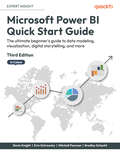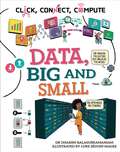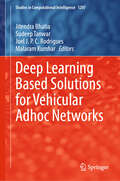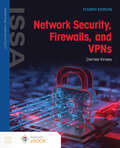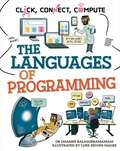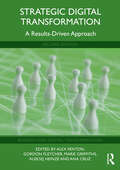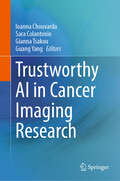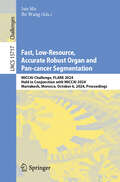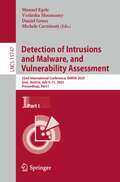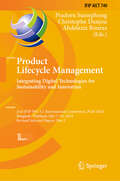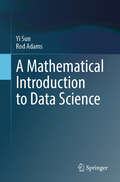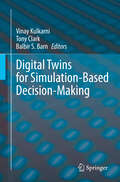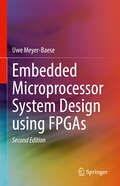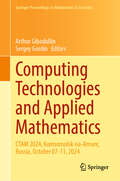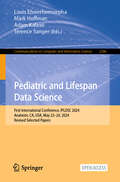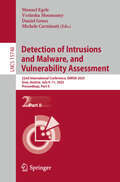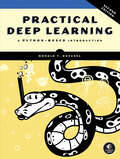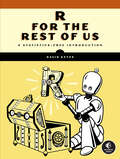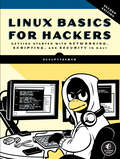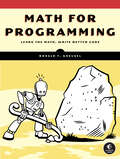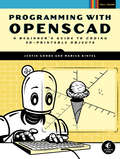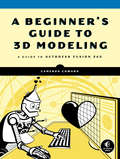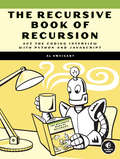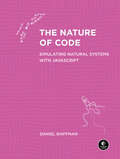- Table View
- List View
Microsoft Power BI Quick Start Guide: The ultimate beginner's guide to data modeling, visualization, digital storytelling, and more, 3rd Edition
by Devin Knight Mitchell Pearson Bradley Schacht Erin OstrowskyBring your data to life with this accessible yet fast-paced introduction to Power BI, now in color.Purchase of the print or Kindle book includes a free eBook in PDF format.Key FeaturesLearn faster with practical examples of the latest features of Power BI, including navigator buttons, column-level security, visualizing goals, and moreMigrate your existing Excel and data analysis skills to Power BIBuild accurate analytical models, reports, and dashboards, now in colorBook DescriptionUpdated with the latest features and improvements in Power BI, this fast-paced yet comprehensive guide will help you master the core concepts of data visualization quickly. You'll learn how to install Power BI, design effective data models, and build basic dashboards and visualizations to help you make better business decisions. This new edition will also help you bridge the gap between MS Excel and Power BI.Throughout this book, you'll learn how to obtain data from a variety of sources and clean it using the Power Query Editor. You'll also start designing data models to navigate and explore relationships within your data and building DAX formulas to make data easier to work with. Visualizing data is a key element of this book, so there's an emphasis on helping you get to grips with data visualization styles and enhanced digital storytelling.As you progress, you'll start building your own dataflows, gain an understanding of the Common Data Model, and automate dataflow refreshes to eradicate data cleaning inefficiency. You'll learn how to administer your organization's Power BI environment so that deployment can be made seamless, data refreshes can run properly, and security can be fully implemented.By the end of this Power BI book, you'll know how to get the most out of Power BI for better business intelligence.What you will learnConnect to data sources using import, DirectQuery, and live connection optionsUse Power Query Editor for data transformation and data cleansing processes, and write M and R scripts and dataflows to do the same in the cloudDesign effective reports with built-in and custom visuals to optimize user experienceImplement row-level and column-level security in your dashboardsAdminister a Power BI cloud tenant for your organizationUse built-in AI capabilities to enhance Power BI data transformation techniquesDeploy your Power BI Desktop files into Power BI Report ServerWho this book is forThis book is for aspiring business intelligence and data professionals with a basic understanding of BI concepts, who want to learn Power BI quickly. Complete beginners with no BI background can also get plenty of useful information from this book.
Data, Big and Small (Click, Connect, Compute #3)
by Dharini BalasubramaniamData science fundamentals, using clear, expert explanations and comic illustrations to spark interest and enthusiasm in the next generation of computer scientists!Data, Big and Small delves into the details behind computer science data and information, which help people and organisations to make decisions. Learn how and why data are created, stored and shared. Find out how we make sense of information through graphs, maps and pictures, and understand how machines learn from the data that we feed them. The end of the book fast-forwards to the future of computer science, data and robotics, and considers what it might mean to live in a 'smarter' world.Contents: What are data? / Data, information and knowledge / Data are vital / Where do data come from? / Getting the format right / Storing all those data / The value is in the processing / Picture it! / Big data / Getting the most out of data / Keeping data secure / A trip into the future of data ... / Pioneer portraits / Further information / Glossary / Quiz yourself! / IndexThe Click, Connect, Compute series untangles the computer science web and teaches children about the essentials of computer software, hardware and digital literacy as well as discussing the ethics surrounding this evolving field. Featuring fun, friendly comic strip illustrations, pioneer bios and a quiz, this is a perfect read for children aged 8+.Books in the series: Computer Science Essentials / Data, Big and Small / Smart Machines / The Languages of ProgrammingWritten in a clear, thoughtful way by computer science expert, Dr. Dharini Balasubramaniam, a strong advocate for ethics and education in her field.
Deep Learning Based Solutions for Vehicular Adhoc Networks (Studies in Computational Intelligence #1207)
by Sudeep Tanwar Joel J. P. C. Rodrigues Jitendra Bhatia Malaram KumharThis book provides a holistic and comprehensive approach to deep learning for vehicular ad hoc networks (VANETs), covering various aspects such as applications, agency involvement, and potential ethical and legal issues. It begins with discussions on how the transportation system has been converted into Intelligent Transportation System (ITS). The use of VANETs is increasing in the development of ITS to enhance road safety, traffic efficiency, and driver comfort. However, the dynamic nature of vehicular environments and the high mobility of vehicles pose significant challenges to designing and implementing VANETs and ensuring reliable and efficient communication. Deep learning, a subset of machine learning, has the potential to revolutionize vehicular ad hoc networks (VANETs) to enable various applications such as traffic management, collision avoidance, and infotainment. DL has demonstrated great potential in addressing various challenges involved in VANETs by leveraging its ability to learn from vast data and make accurate predictions. It reviews the state-of-the-art DL-based approaches for various applications in VANETs, including routing, congestion control, autonomous driving, and security. In addition, this book provides a comprehensive analysis of these approaches' advantages and limitations and discusses their future research directions. The study in this book shows that DL-based techniques can significantly improve the performance and reliability of VANETs. Still, in-depth research is required to address the challenges of deploying these methods in real-world scenarios. Finally, the book discusses the potential of DL-based VANETs in supporting other emerging technologies, such as autonomous driving and smart cities. It explores the simulation/emulation tools for practical exposure to the vehicular ad hoc network.
Network Security, Firewalls, and VPNs
by Denise KinseyNetwork Security, Firewalls, and VPNs, Fourth Edition, offers a comprehensive, vendor-neutral introduction to network security, covering firewalls, intrusion detection and prevention systems, and VPNs. Written in a clear and engaging style, the text transitions smoothly from basic principles to advanced topics, incorporating real-world examples and practical applications. Readers will find definitions, operational explanations, and examples that foster a solid understanding of how these technologies function and integrate within networks. The Fourth Edition has been completely rewritten to reflect current technologies and practices, with expanded coverage of SIEM, SOAR, SOC implementation, cloud security, and cryptography uses and protections. It includes hands-on labs and exercises to help readers practice concepts directly. Aligned with the NIST NICE Framework and NSA CAE knowledge units, this edition is well-suited for IT, networking, information systems, and cybersecurity programs. Features and Benefits Rewritten to seamlessly integrate baseline network technologies with new tools for a complete, up-to-date security resource Offers expanded coverage of SIEM, SOAR, SOC implementation, cloud security, and cryptography uses and protections Includes step-by-step, hands-on exercises that help readers apply concepts and build a strong, practical understanding Aligns to NIST NICE Framework v2.0.0 work roles and fully covers NSA CAE Knowledge Units (KUs) for curriculum alignment Provides vendor-neutral, real-world examples to help demonstrate application across devices, systems, and network setups Instructor resources include: Test Bank, PowerPoint Slides, Sample Syllabi, Instructor Manual, Answers to Labs, and more Available with updated cybersecurity Cloud Labs, which provide realistic, hands-on practice that aligns with course content
The Languages of Programming (Click, Connect, Compute #4)
by Dharini BalasubramaniamComputer language fundamentals, using clear, expert explanations and comic illustrations to spark interest and enthusiasm in the next generation of computer scientists!The Languages of Programming looks at the definitions and uses of languages, bot natural and constructed. Readers will find out about the elements of a programming language, the best types of language to use at each stage of the software life cycle, and about the tools that help to solve difficult programming problems and complex tasks such as monitoring air traffic. And the end of the book fast-forwards to the future of computer science, languages and robotics and considers what it might mean to live in a 'smarter' world.Contents: What is a language? / Languages can come naturally ... / ... or languages can be constructed / Language types for CS / Even more languages! / It's all syntax and semantics / Ways of programming / Choose your language / Programming is a process / Tools to make our work easier / Case study: Blocks vs Python / The future of programming languages / Pioneer portraits / Further information / Glossary / Quiz yourself! / IndexThe Click, Connect, Compute series untangles the computer science web and teaches children about the essentials of computer software, hardware and digital literacy, as well as discussing the ethics surrounding this evolving field. Featuring fun, friendly comic strip illustrations, pioneer bios and a quiz, this is a perfect read for children aged 8+.Books in the series: Computer Science Essentials / Data, Big and Small / Smart Machines / The Languages of ProgrammingWritten in a clear, thoughtful way by computer science expert, Dr. Dharini Balasubramaniam, a strong advocate for ethics and education in her field.
Strategic Digital Transformation: A Results-Driven Approach (Business and Digital Transformation)
by Alex FentonEmerging technologies are having a profound impact upon individuals and organisations. The “always on” attitude that digital technologies encourage brings an equal mix of benefits and challenges. The ready availability of digital technology has transformed the way we live, learn, play and interact – but how a business can turn the tools into an economic and organisational advantage is not always clear.This new edition of Strategic Digital Transformation enables students and business leaders to take a strategic and sustainable approach to realising the value of digital technologies. It offers results-driven solutions that successfully transform organisations into data-driven, people-focused businesses capable of sustainably competing at a global level. These solutions are significantly shaped by the need for organisational digital maturity, high levels of digital and cultural interoperability and the purposeful application of AI. With four key areas of focus, the material moves through understanding digital business to planning, implementing and assessing digital transformation. The current challenges facing all small organisations, including limited resources, financial pressures and the lack of dedicated IT departments, are explored. The authors consider the ways in which innovation can increase competitive advantage, how innovative business models can create new opportunities and how a data-driven perspective can release embedded value within the organisation. Contemporary international case studies and examples throughout each chapter bridge theory with practical application and systematically document the patterns of activities that enable success. All chapters have been completely revised and updated to reflect advances in technology and to highlight the social and economic consequences of digital transformation.This textbook is a vital resource for postgraduate and undergraduate students of digital business, innovation and transformation. By showing how to initiate digital transformation across an organisation, it will prepare business owners, directors and management of small- and medium-sized businesses to take strategic advantage of new and emerging technologies to stay ahead of their competition.
Judicial Anti-Corruption Campaigns: Prosecutions in Italy, Brazil and Romania (Routledge Corruption and Anti-Corruption Studies)
by Nedim HogicThis book offers a comparative analysis of cases of mass prosecutions for political corruption in Italy, Brazil, and Romania.The book outlines how judicial showdowns with political corruption emerge, what consequences they create, and whether they can be considered legitimate judicial operations or coups orchestrated by political forces with the assistance of the judiciary. Due to the similarities exhibited in the legal, political, and economic spheres of the events, the book explores the Italian Mani Pulite, Brazilian Lava Jato, and Romanian judicial anti-corruption campaigns. These campaigns were simultaneously legal operations, narratives created by the media, and opportunities for the emergence of new political actors. The book demonstrates why judicial activity was a crucial tool for reducing and preventing corruption in these countries. In addition to investigating the key legal issues and narratives, the book explores the controversies of these campaigns and assesses whether they should be seen as judicial revolutions or cases of prosecutorial overreach.Providing a holistic comparative assessment of judicial means as a tool for controlling corruption, this book will be of interest to academics in the fields of Corruption Studies, Law, Development Studies, and Political Science.
Trustworthy AI in Cancer Imaging Research
by Ioanna Chouvarda Guang Yang Sara Colantonio Gianna TsakouThe book covers multiple aspects and challenges, from legal to technical and validation, in the emerging topic of AI in cancer imaging, bringing together the experience of top researchers and flagship projects. The aim of this book is to address the important questions: &“How to design AI that is trustworthy&”, and &“How to validate AI trustworthiness&” in the scope of AI for cancer imaging research. The book discusses overall considerations and the generation of a framework; preparing for trustworthy AI, including the data and metadata for quality, transparency and traceability; implementing trustworthy AI with algorithms and Decision Support Systems; and validating trustworthy AI. This is an ideal resource for researchers from technical and clinical research sites, postgraduate students, and healthcare professionals in cancer imaging and beyond.
Fast, Low-Resource, Accurate Robust Organ and Pan-cancer Segmentation: MICCAI Challenge, FLARE 2024, Held in Conjunction with MICCAI 2024, Marrakesh, Morocco, October 6, 2024, Proceedings (Lecture Notes in Computer Science #15717)
by Jun Ma Bo WangThis book constitutes the proceedings of the MICCAI 2024 Challenge, FLARE 2024, held in Conjunction with MICCAI 2024, in Marrakesh, Morocco, during October 2024. The 20 full papers included in this book were carefully reviewed and selected from 24 submissions. They describe the solutions the participants found for automatic abdominal organ and pan-cancer segmentation using the official training dataset released for this pupose. This challenge focuses on both organ and pan-cancer segmentation, including three subtasks: Subtask 1: Pan-cancer segmentation in CT scansSubtask 2: Abdominal CT organ segmentation on laptopSubtask 3: Unsupervised domain adaptation for abdominal organ segmentation in MRI Scans
Detection of Intrusions and Malware, and Vulnerability Assessment: 22nd International Conference, DIMVA 2025, Graz, Austria, July 9–11, 2025, Proceedings, Part I (Lecture Notes in Computer Science #15747)
by Daniel Gruss Michele Carminati Manuel Egele Veelasha MoonsamyThe two-volume set LNCS 15747 and 15748 constitutes the refereed conference proceedings of the 12nd International Conference on Detection of Intrusions and Malware, and Vulnerability Assessment, DIMVA 2025, held in Graz, Austria, during July 9–11, 2025. The 25 revised full papers and 11 posters are presented in these proceedings were carefully reviewed and selected from 103 submissions. The papers are organized in the following topical sections: Part I: Web Security; Vulnerability Detection; Side channels; and Obfuscation. Part II: AI/ML & Security; Android & Patches; OS & Network; and Resilient Systems.
Product Lifecycle Management. Integrating Digital Technologies for Sustainability and Innovation: 21st IFIP WG 5.1 International Conference, PLM 2024, Bangkok, Thailand, July 7–10, 2024, Revised Selected Papers, Part I (IFIP Advances in Information and Communication Technology #740)
by Abdelaziz Bouras Christophe Danjou Pradorn SureephongThis two-volume set constitutes the refereed proceedings of the 21st IFIP WG 5.1 International Conference on Product Lifecycle Management, PLM 2024, held in Bangkok, Thailand, during July 7-10, 2024. The 64 full papers presented in this book were carefully reviewed and selected from 105 submissions. PLM 2024 aims to integrate business approaches to the collaborative creation, management and dissemination of product and process data throughout the extended enterprises that create, manufacture and operate engineered products and systems.
A Mathematical Introduction to Data Science
by Yi Sun Rod AdamsThis textbook provides a comprehensive foundation in the mathematics needed for data science for students and self-learners with a basic mathematical background who are interested in the principles behind computational algorithms in data science. It covers sets, functions, linear algebra, and calculus, and delves deeply into probability and statistics, which are key areas for understanding the algorithms driving modern data science applications. Readers are guided toward unlocking the secrets of algorithms like Principal Component Analysis, Singular Value Decomposition, Linear Regression in two and more dimensions, Simple Neural Networks, Maximum Likelihood Estimation, Logistic Regression and Ridge Regression, illuminating the path from mathematical principles to algorithmic mastery. It is designed to make the material accessible and engaging, guiding readers through a step-by-step progression from basic mathematical concepts to complex data science algorithms. It stands out for its emphasis on worked examples and exercises that encourage active participation, making it particularly beneficial for those with limited mathematical backgrounds but a strong desire to learn. This approach facilitates a smoother transition into more advanced topics. The authors expect readers to be proficient in handling numbers in various formats, including fractions, decimals, percentages, and surds. They should also have a knowledge of introductory algebra, such as manipulating simple algebraic expressions, solving simple equations, and graphing elementary functions, along with a basic understanding of geometry including angles, trigonometry and Pythagoras’ theorem.
Digital Twins for Simulation-Based Decision-Making
by Tony Clark Balbir S. Barn Vinay KulkarniThis book introduces the concept of digital twins and their purposive usage, including the technology infrastructure and the method support necessary for their construction. The landscape of digital twins is illustrated through a range of use cases spread across different application domains such as strategy and business assessment in enterprises, logistics networks, manufacturing industries, chemical and refinery systems, sustainable food ecosystems, and public healthcare. All these examples show how digital twins are exploited to simulate complex scenarios depending on various external factors – all of which would not be feasible as real-world simulations because of their high costs, potential fatal damages, and unpredictable side effects. The book is written for professionals in industry who would like to learn about the application of these powerful methodologies and tools in various areas as well as for researchers in computer science who would like to draw inspirations for further development of this technology from real-world applications.
Embedded Microprocessor System Design using FPGAs
by Uwe Meyer-BaeseThis textbook for courses in Embedded Systems introduces students to necessary concepts, through a hands-on approach. It gives a great introduction to FPGA-based microprocessor system design using state-of-the-art boards, tools, and microprocessors from Altera/Intel® and Xilinx®. HDL-based designs (soft-core), parameterized cores (Nios II and MicroBlaze), and ARM Cortex-A9 design are discussed, compared and explored using many hand-on designs projects. Custom IP for HDMI coder, Floating-point operations, and FFT bit-swap are developed, implemented, tested and speed-up is measured. New additions in the second edition include bottom-up and top-down FPGA-based Linux OS system designs for Altera/Intel® and Xilinx® boards and application development running on the OS using modern popular programming languages: Python, Java, and JavaScript/HTML/CSSs. Downloadable files include all design examples such as basic processor synthesizable code for Xilinx and Altera tools for PicoBlaze, MicroBlaze, Nios II and ARMv7 architectures in VHDL and Verilog code, as well as the custom IP projects. For the three new OS enabled programing languages a substantial number of examples ranging from basic math and networking to image processing and video animations are provided. Each Chapter has a substantial number of short quiz questions, exercises, and challenging projects.
Computing Technologies and Applied Mathematics: CTAM 2024, Komsomolsk-na-Amure, Russia, October 07-11, 2024 (Springer Proceedings in Mathematics & Statistics #500)
by Arthur Gibadullin Sergey GordinThis proceedings volume convenes revised, selected works presented at the 3rd International Seminar on Computing Technologies and Applied Mathematics (CTAM2024), held at Komsomolsk-na-Amure State University, Russia, from October 7 to 11, 2024. The seminar brought together a diverse group of international experts and young scientists from Germany, China, South Korea, Uzbekistan, and Russia to exchange the latest results and original ideas on the use of computing technologies and applied mathematics tools in both fundamental and applied research. Topics covered in this volume include the development of theoretical foundations, methods, and algorithms for implementing mathematical and computational models. The subjects ranged from health to logistics, with many devoted to algorithm optimization. Industrial applications are also covered, with studies of digital twins and quantum and evolutionary algorithms. By bridging academia and industry, this volume can benefit graduate students, experienced researchers, and industry practitioners alike, fostering both practical implementations in real-world scenarios and innovative avenues of applied research.
Pediatric and Lifespan Data Science: First International Conference, IPLDSC 2024, Anaheim, CA, USA, May 23–24, 2024, Revised Selected Papers (Communications in Computer and Information Science #2386)
by Mark Hoffman Louis Ehwerhemuepha Adam Kalawi Terence SangerThis open access book will address the unique requirements and technological tools for analysis of data across the lifespan, from childhood through advanced age. Topics such as sepsis, hospital-acquired infections, mental health, health equity, precision medicine, large language models and generative artificial intelligence, computer vision, ethical use of artificial intelligence, and large real-world electronic health record databases will be covered.
Detection of Intrusions and Malware, and Vulnerability Assessment: 22nd International Conference, DIMVA 2025, Graz, Austria, July 9–11, 2025, Proceedings, Part II (Lecture Notes in Computer Science #15748)
by Daniel Gruss Michele Carminati Manuel Egele Veelasha MoonsamyThe two-volume set LNCS 15747 and 15748 constitutes the refereed conference proceedings of the 12nd International Conference on Detection of Intrusions and Malware, and Vulnerability Assessment, DIMVA 2025, held in Graz, Austria, during July 9–11, 2025. The 25 revised full papers and 11 posters are presented in these proceedings were carefully reviewed and selected from 103 submissions. The papers are organized in the following topical sections: Part I: Web Security; Vulnerability Detection; Side channels; and Obfuscation. Part II: AI/ML & Security; Android & Patches; OS & Network; and Resilient Systems.
Practical Deep Learning, 2nd Edition: A Python-Based Introduction
by Ronald T. KneuselDeep learning made simple.Dip into deep learning without drowning in theory with this fully updated edition of Practical Deep Learning from experienced author and AI expert Ronald T. Kneusel.After a brief review of basic math and coding principles, you&’ll dive into hands-on experiments and learn to build working models for everything from image analysis to creative writing, and gain a thorough understanding of how each technique works under the hood. Whether you&’re a developer looking to add AI to your toolkit or a student seeking practical machine learning skills, this book will teach you:How neural networks work and how they&’re trainedHow to use classical machine learning modelsHow to develop a deep learning model from scratchHow to evaluate models with industry-standard metricsHow to create your own generative AI modelsEach chapter emphasizes practical skill development and experimentation, building to a case study that incorporates everything you&’ve learned to classify audio recordings. Examples of working code you can easily run and modify are provided, and all code is freely available on GitHub. With Practical Deep Learning, second edition, you&’ll gain the skills and confidence you need to build real AI systems that solve real problems.New to this edition: Material on computer vision, fine-tuning and transfer learning, localization, self-supervised learning, generative AI for novel image creation, and large language models for in-context learning, semantic search, and retrieval-augmented generation (RAG).
R for the Rest of Us: A Statistics-Free Introduction
by David KeyesLearn how to use R for everything from workload automation and creating online reports, to interpreting data, map making, and more.Written by the founder of a very popular online training platform for the R programming language!The R programming language is a remarkably powerful tool for data analysis and visualization, but its steep learning curve can be intimidating for some. If you just want to automate repetitive tasks or visualize your data, without the need for complex math, R for the Rest of Us is for you.Inside you&’ll find a crash course in R, a quick tour of the RStudio programming environment, and a collection of real-world applications that you can put to use right away. You&’ll learn how to create informative visualizations, streamline report generation, and develop interactive websites—whether you&’re a seasoned R user or have never written a line of R code.You&’ll also learn how to:• Manipulate, clean, and parse your data with tidyverse packages like dplyr and tidyr to make data science operations more user-friendly• Create stunning and customized plots, graphs, and charts with ggplot2 to effectively communicate your data insights• Import geospatial data and write code to produce visually appealing maps automatically• Generate dynamic reports, presentations, and interactive websites with R Markdown and Quarto that seamlessly integrate code, text, and graphics• Develop custom functions and packages tailored to your specific needs, allowing you to extend R&’s functionality and automate complex tasksUnlock a treasure trove of techniques to transform the way you work. With R for the Rest of Us, you&’ll discover the power of R to get stuff done. No advanced statistics degree required.
Linux Basics for Hackers, 2nd Edition: Getting Started with Networking, Scripting, and Security in Kali
by OccupyTheWebA revised introduction to the Linux operating system for beginning hackers and penetration testers.If you&’re just getting started along the exciting path of hacking, cybersecurity, and pentesting, Linux Basics for Hackers is an excellent introduction. With Kali Linux, an operating system designed for digital forensics and penetration testing, you&’ll learn the basics of using Linux and acquire the tools and techniques you&’ll need to take control of a Linux environment.First, you&’ll learn how to install Kali on a virtual machine and get an introduction to basic Linux concepts. Next, you&’ll tackle broader Linux topics like manipulating text, controlling file and directory permissions, and managing user environment variables. You&’ll then focus on foundational hacking concepts like security and anonymity and learn scripting skills with bash and Python. Practical tutorials and exercises throughout will reinforce and test your skills as you learn how to:Cover your tracks by changing your network information and manipulating the journalctl logging utilityWrite a tool to scan for network connections, and connect and listen to wireless networksKeep your internet activity stealthy using Tor, proxy servers, VPNs, and encrypted emailWrite a bash script to find potential attack targets over a range of IP addressesUse and abuse services like MySQL, the Apache web server, and OpenSSHBuild your own hacking tools, such as remote spy cameras and password crackersNew to this edition: This second edition has been updated to address recent changes to Kali and Linux, including a more secure approach to root privileges, updates to Bluetooth and Linux logging functions, and a new chapter with advice on AI in cybersecurity.Hacking is complex, and there is no single way in. Why not start at the beginning with Linux Basics for Hackers?
Math for Programming
by Ronald T. KneuselA one-stop-shop for all the math you should have learned for your programming career.Every great programming challenge has mathematical principles at its heart. Whether you&’re optimizing search algorithms, building physics engines for games, or training neural networks, success depends on your grasp of core mathematical concepts. In Math for Programming, you&’ll master the essential mathematics that will take you from basic coding to serious software development. You&’ll discover how vectors and matrices give you the power to handle complex data, how calculus drives optimization and machine learning, and how graph theory leads to advanced search algorithms.Through clear explanations and practical examples, you&’ll learn to:Harness linear algebra to manipulate data with unprecedented efficiencyApply calculus concepts to optimize algorithms and drive simulationsUse probability and statistics to model uncertainty and analyze dataMaster the discrete mathematics that powers modern data structuresSolve dynamic problems through differential equationsWhether you&’re seeking to fill gaps in your mathematical foundation or looking to refresh your understanding of core concepts, Math for Programming will turn complex math into a practical tool you&’ll use every day.
Programming with OpenSCAD: A Beginner's Guide to Coding 3D-Printable Objects
by Justin Gohde Marius KintelProgramming with OpenSCAD is a STEM-focused, learn-to-code book for beginners that introduces core computational thinking concepts through the design of 3D-printable objects. Develop coding skills as you build increasingly complex 3D models and print them into fun games, puzzles, and more.OpenSCAD is freely available open source software that enables nondesigners to easily create 3D designs using a text-based programming language. It&’s a great language for beginners because the instant 3D visualization gives you immediate feedback on the results of your code. This book channels OpenSCAD&’s visual benefits and user-friendliness into a STEAM-focused, project-based tutorial that teaches the basics of coding, 3D printing, and computational thinking while you develop your spatial reasoning by creating 3D designs with OpenSCAD. Presuming no prior experience with either programming or 3D design, each chapter builds a scaffolded understanding of core concepts. You&’ll start by defining, drawing and displaying geometric primitives with text-based code, then expand your creative toolbox with transformation operations – like rotating, reflecting, scaling, and combining shapes. As the projects become more sophisticated, so will your programming skills; you&’ll use loops for replicating objects, if statements for differentiating your designs, and parameterized, self-contained modules to divide longer scripts into separate files. Along the way, you'll learn 3D printing tips so that you can produce physical mementos of your progress and get physical feedback that lets you correct mistakes in real time. In addition, the book provides hands-on and accessible design exercises at the end of each chapter so that you can practice applying new concepts immediately after they are introduced. You&’ll learn:Programming basics like working with variables, loops, conditional statements, and parameterized modulesTransformation operations, such as rotate, reflect, and scale, to create complex shapesExtrusion techniques for turning 2D shapes into elaborate 3D designsComputational-thinking concepts, including decomposition, abstraction, and pattern recognition OpenSCAD&’s Boolean, Minkowski and hull operations for combining multiple 3D shapes into one3D design fundamentals, like navigating the xyz-axis, orthogonal vs. perspective views, and constructive solid geometryOrganizing bigger designs into separate files to make code more readable and collaborative Accessibly written for a wide audience (advanced middle schoolers, high school students, college students, artists, makers and lifelong-learners alike), this is the perfect guide to becoming proficient at programming in general and 3D modeling in particular.
A Beginner's Guide to 3D Modeling: A Guide to Autodesk Fusion 360
by Cameron CowardA Beginner&’s Guide to 3D Modeling is a project-based, straightforward introduction to computer-aided design (CAD). You&’ll learn how to use Autodesk Fusion 360, the world&’s most powerful free CAD software, to model gadgets, 3D print your designs, and create realistic images just like an engineering professional—with no experience required! Hands-on modeling projects and step-by-step instructions throughout the book introduce fundamental 3D modeling concepts. As you work through the projects, you&’ll master the basics of parametric modeling and learn how to create your own models, from simple shapes to multipart assemblies. Once you&’ve mastered the basics, you&’ll learn more advanced modeling concepts like sweeps, lofts, surfaces, and rendering, before pulling it all together to create a robotic arm. You&’ll learn how to:• Design a moving robotic arm, a door hinge, a teapot, and a 20-sided die• Create professional technical drawings for manufacturing and patent applications • Model springs and other complex curves to create realistic designs • Use basic Fusion 360 tools like Extrude, Revolve, and Hole• Master advanced tools like Coil and ThreadWhether you&’re a maker, hobbyist, or artist, A Beginner&’s Guide to 3D Modeling is certain to show you how to turn your ideas into professional models. Go ahead—dust off that 3D printer and feed it your amazing designs.
The Recursive Book of Recursion: Ace the Coding Interview with Python and JavaScript
by Al SweigartAn accessible yet rigorous crash course on recursive programming using Python and JavaScript examples.Recursion has an intimidating reputation: it&’s considered to be an advanced computer science topic frequently brought up in coding interviews. But there&’s nothing magical about recursion. The Recursive Book of Recursion uses Python and JavaScript examples to teach the basics of recursion, exposing the ways that it&’s often poorly taught and clarifying the fundamental principles of all recursive algorithms. You&’ll learn when to use recursive functions (and, most importantly, when not to use them), how to implement the classic recursive algorithms often brought up in job interviews, and how recursive techniques can help solve countless problems involving tree traversal, combinatorics, and other tricky topics. This project-based guide contains complete, runnable programs to help you learn: How recursive functions make use of the call stack, a critical data structure almost never discussed in lessons on recursionHow the head-tail and &“leap of faith&” techniques can simplify writing recursive functionsHow to use recursion to write custom search scripts for your filesystem, draw fractal art, create mazes, and moreHow optimization and memoization make recursive algorithms more efficient Al Sweigart has built a career explaining programming concepts in a fun, approachable manner. If you&’ve shied away from learning recursion but want to add this technique to your programming toolkit, or if you&’re racing to prepare for your next job interview, this book is for you.
The Nature of Code: Simulating Natural Systems with JavaScript
by Daniel ShiffmanAll aboard The Coding Train! This beginner-friendly creative coding tutorial is designed to grow your skills in a fun, hands-on way as you build simulations of real-world phenomena with &“The Coding Train&” YouTube star Daniel Shiffman.What if you could re-create the awe-inspiring flocking patterns of birds or the hypnotic dance of fireflies—with code? For over a decade, The Nature of Code has empowered countless readers to do just that, bridging the gap between creative expression and programming. This innovative guide by Daniel Shiffman, creator of the beloved Coding Train, welcomes budding and seasoned programmers alike into a world where code meets playful creativity.This JavaScript-based edition of Shiffman&’s groundbreaking work gently unfolds the mysteries of the natural world, turning complex topics like genetic algorithms, physics-based simulations, and neural networks into accessible and visually stunning creations.Embark on this extraordinary adventure with projects involving:A physics engine: Simulate the push and pull of gravitational attraction.Flocking birds: Choreograph the mesmerizing dance of a flock.Branching trees: Grow lifelike and organic tree structures.Neural networks: Craft intelligent systems that learn and adapt.Cellular automata: Uncover the magic of self-organizing patterns.Evolutionary algorithms: Play witness to natural selection in your code.Shiffman&’s work has transformed thousands of curious minds into creators, breaking down barriers between science, art, and technology, and inviting readers to see code not just as a tool for tasks but as a canvas for boundless creativity.Whether you&’re deciphering the elegant patterns of natural phenomena or crafting your own digital ecosystems, Shiffman&’s guidance is sure to inform and inspire. The Nature of Code is not just about coding; it&’s about looking at the natural world in a new way and letting its wonders inspire your next creation. Dive in and discover the joy of turning code into art—all while mastering coding fundamentals along the way.NOTE: All examples are written with p5.js, a JavaScript library for creative coding, and are available on the book's website.
